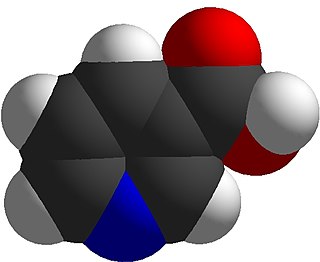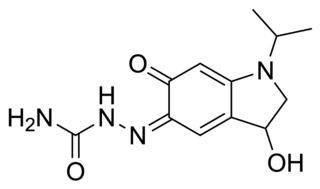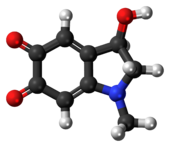
Phencyclidine or phenylcyclohexyl piperidine (PCP), also known in its use as a street drug as angel dust among other names, is a dissociative anesthetic mainly used recreationally for its significant mind-altering effects. PCP may cause hallucinations, distorted perceptions of sounds, and violent behavior. As a recreational drug, it is typically smoked, but may be taken by mouth, snorted, or injected. It may also be mixed with cannabis or tobacco.

Schizophrenia is a mental disorder characterized by hallucinations, delusions, disorganized thinking and behavior, and flat or inappropriate affect. Symptoms develop gradually and typically begin during young adulthood and are never resolved. There is no objective diagnostic test; diagnosis is based on observed behavior, a psychiatric history that includes the person's reported experiences, and reports of others familiar with the person. For a diagnosis of schizophrenia, the described symptoms need to have been present for at least six months or one month. Many people with schizophrenia have other mental disorders, especially mood disorders, anxiety disorders, and obsessive–compulsive disorder.

Niacin, also known as nicotinic acid, is an organic compound and a vitamer of vitamin B3, an essential human nutrient. It is produced by plants and animals from the amino acid tryptophan. Niacin is obtained in the diet from a variety of whole and processed foods, with highest contents in fortified packaged foods, meat, poultry, red fish such as tuna and salmon, lesser amounts in nuts, legumes and seeds. Niacin as a dietary supplement is used to treat pellagra, a disease caused by niacin deficiency. Signs and symptoms of pellagra include skin and mouth lesions, anemia, headaches, and tiredness. Many countries mandate its addition to wheat flour or other food grains, thereby reducing the risk of pellagra.

Clozapine, sold under the brand name Clozaril among others, is a psychiatric medication and was the first atypical antipsychotic to be discovered. It is primarily used to treat people with schizophrenia and schizoaffective disorder who have had an inadequate response to two other antipsychotics, or who have been unable to tolerate other drugs due to extrapyramidal side effects. It is also used for the treatment of psychosis in Parkinson's disease.

Quetiapine, sold under the brand name Seroquel among others, is an atypical antipsychotic medication used for the treatment of schizophrenia, bipolar disorder, and major depressive disorder. Despite being widely used as a sleep aid due to its sedating effect, the benefits of such use may not outweigh its undesirable side effects. It is taken orally.
Dissociatives, colloquially dissos, are a subclass of hallucinogens that distort perception of sight and sound and produce feelings of detachment – dissociation – from the environment and/or self. Although many kinds of drugs are capable of such action, dissociatives are unique in that they do so in such a way that they produce hallucinogenic effects, which may include dissociation, a general decrease in sensory experience, hallucinations, dream-like states or anesthesia. Despite most dissociatives' main mechanism of action being tied to NMDA receptor antagonism, some of these substances, which are nonselective in action and affect the dopamine and/or opioid systems, may be capable of inducing more direct and repeatable euphoria or symptoms which are more akin to the effects of typical "hard drugs" or common drugs of abuse. This is likely why dissociatives are considered to be addictive with a fair to moderate potential for abuse, unlike psychedelics. Despite some dissociatives, such as phencyclidine (PCP) possessing stimulating properties, most dissociatives seem to have a general depressant effect and can produce sedation, respiratory depression, nausea, disorientation, analgesia, anesthesia, ataxia, cognitive and memory impairment as well as amnesia.
Orthomolecular medicine is a form of alternative medicine that claims to maintain human health through nutritional supplementation. It is rejected by evidence-based medicine. The concept builds on the idea of an optimal nutritional environment in the body and suggests that diseases reflect deficiencies in this environment. Treatment for disease, according to this view, involves attempts to correct "imbalances or deficiencies based on individual biochemistry" by use of substances such as vitamins, minerals, amino acids, trace elements and fatty acids. The notions behind orthomolecular medicine are not supported by sound medical evidence, and the therapy is not effective for chronic disease prevention; even the validity of calling the orthomolecular approach a form of medicine has been questioned since the 1970s.
Humphry Fortescue Osmond was an English psychiatrist who moved to Canada and later the United States. He is known for inventing the word psychedelic and for his research into interesting and useful applications for psychedelic drugs. Osmond also explored aspects of the psychology of social environments, in particular how they influenced welfare or recovery in mental institutions.
Orthomolecular psychiatry is the use of orthomolecular medicine for mental illness. Orthomolecular psychiatry has been rejected by evidence-based medicine and has been called quackery. The approach uses unorthodox forms of individualized testing and diagnosis to attempt to establish an etiology for each patient's specific symptoms, and claims to tailor the treatment accordingly, using a combination of nutrients, dietary changes and medications that are claimed to enhance quality of life and functionality as well as to reduce or eliminate symptoms and the use of xenobiotic drugs. Scientific studies have shown mixed results; although there are some promising results from nutritional psychiatry, some forms of orthomolecular psychiatry are ineffective.

Abram Hoffer was a Canadian biochemist, physician, and psychiatrist known for his "adrenochrome hypothesis" of schizoaffective disorders. According to Hoffer, megavitamin therapy and other nutritional interventions are potentially effective treatments for cancer and schizophrenia. Hoffer was also involved in studies of LSD as an experimental therapy for alcoholism and the discovery that high-dose niacin can be used to treat high cholesterol and other dyslipidemias. Hoffer's ideas about megavitamin therapy to treat mental illness are not accepted by the medical community.
Megavitamin therapy is the use of large doses of vitamins, often many times greater than the recommended dietary allowance (RDA) in the attempt to prevent or treat diseases. Megavitamin therapy is typically used in alternative medicine by practitioners who call their approach orthomolecular medicine. Vitamins are useful in preventing and treating illnesses specifically associated with dietary vitamin shortfalls, but the conclusions of medical research are that the broad claims of disease treatment by advocates of megavitamin therapy are unsubstantiated by the available evidence. It is generally accepted that doses of any vitamin greatly in excess of nutritional requirements will result either in toxicity or in the excess simply being metabolised; thus evidence in favour of vitamin supplementation supports only doses in the normal range. Critics have described some aspects of orthomolecular medicine as food faddism or even quackery. Research on nutrient supplementation in general suggests that some nutritional supplements might be beneficial, and that others might be harmful; several specific nutritional therapies are associated with an increased likelihood of the condition they are meant to prevent.
The Journal of Orthomolecular Medicine was established in 1967 by Abram Hoffer. It publishes studies in nutritional and orthomolecular medicine. There is controversy surrounding the journal, as the validity of the field of orthomolecular medicine is not widely accepted by mainstream medicine. The journal is ranked in the bottom 10 percent of all journals about complementary and alternative medicine that are indexed in the bibliographic database Scopus.

Arecoline is a nicotinic acid-based mild parasympathomimetic stimulant alkaloid found in the areca nut, the fruit of the areca palm. It is an odourless oily liquid. It can bring a sense of enhanced alertness and energy along with mild feelings of euphoria and relaxation.
Carl Curt Pfeiffer was a physician and biochemist who researched schizophrenia, allergies and other diseases. He was Chair of the Pharmacology Department at Emory University and considered himself a founder of what two-time Nobel prize winner, [Pauling, PhD.], named orthomolecular psychiatry and published in the Journal Science. 1968 Apr 19;160(3825):265-71.

Heterocyclic amines, also sometimes referred to as HCAs, are chemical compounds containing at least one heterocyclic ring, which by definition has atoms of at least two different elements, as well as at least one amine (nitrogen-containing) group. Typically it is a nitrogen atom of an amine group that also makes the ring heterocyclic, though compounds exist in which this is not the case. The biological functions of heterocyclic amines vary, including vitamins and carcinogens. Carcinogenic heterocyclic amines are created by high temperature cooking of meat and smoking of plant matter like tobacco. Some well known heterocyclic amines are niacin, nicotine, and the nucleobases that encode genetic information in DNA.
The management of schizophrenia usually involves many aspects including psychological, pharmacological, social, educational, and employment-related interventions directed to recovery, and reducing the impact of schizophrenia on quality of life, social functioning, and longevity.

Laropiprant (INN) was a drug used in combination with niacin to reduce blood cholesterol that is no longer sold, due to increases in side-effects with no cardiovascular benefit. Laropiprant itself has no cholesterol lowering effect, but it reduces facial flushes induced by niacin.

Iprazochrome is an antimigraine agent used for prophylaxis of the attacks. It is also indicated for diabetic retinopathy.
John Raymond Smythies was a British neuropsychiatrist, neuroscientist and neurophilosopher.
Immuno-psychiatry, according to Pariante, is a discipline that studies the connection between the brain and the immune system. It differs from psychoneuroimmunology by postulating that behaviors and emotions are governed by peripheral immune mechanisms. Depression, for instance, is seen as malfunctioning of the immune system.












